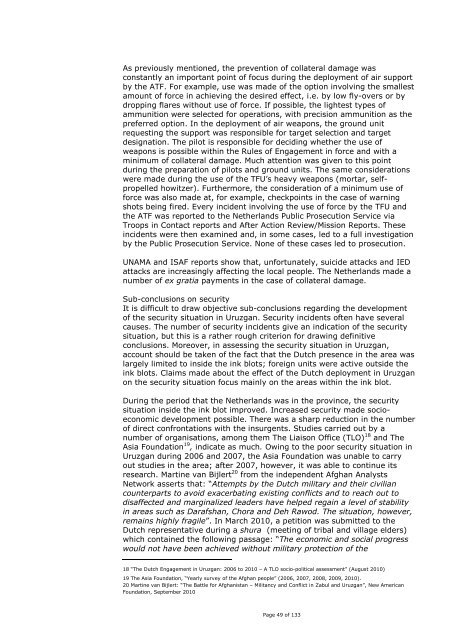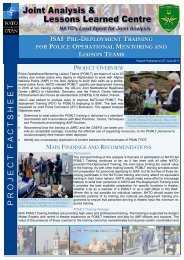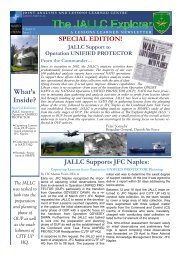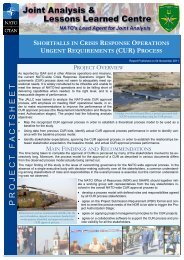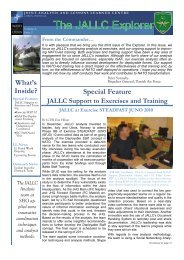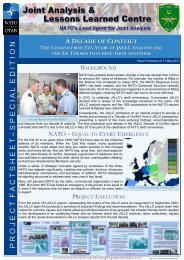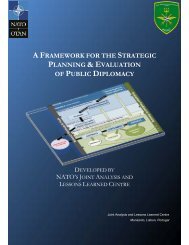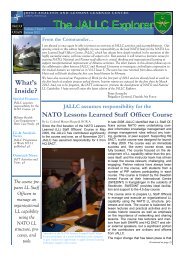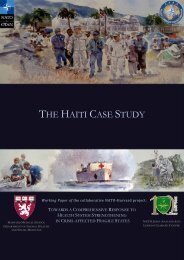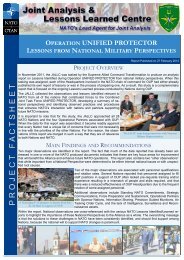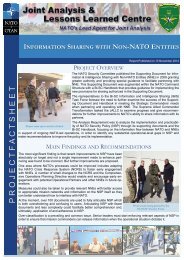that were put <strong>in</strong> place had the desired effect, an effect particularlyimportant to the <strong>Netherlands</strong>. Unfortunately, the numbers of civiliancasualties result<strong>in</strong>g from the activities of the <strong>in</strong>surgents cont<strong>in</strong>ued to rise.The <strong>in</strong>surgents’ plant<strong>in</strong>g of IEDs was a particular source of casualties amongcivilians. By plant<strong>in</strong>g IEDs near police posts or recruit<strong>in</strong>g stations, thecivilian population sometimes became an <strong>in</strong>tentional target of the<strong>in</strong>surgents. The <strong>in</strong>surgents also killed civilians cooperat<strong>in</strong>g with <strong>ISAF</strong> as ameans of deterrence.In the <strong>2006</strong> – <strong>2010</strong> period, <strong>ISAF</strong> was also a cause of civilian casualties <strong>in</strong>Uruzgan. The Dutch government deeply regrets the fact that casualtieswere caused among the local people. In Uruzgan, <strong>ISAF</strong> units operatedunder Dutch command, but coalition partners (US OEF and AUS SF) alsocarried out operations <strong>in</strong> Uruzgan that were not under TFU command. Theexact number of civilian casualties caused by Dutch actions can thereforenot be established with any degree of certa<strong>in</strong>ty. This uncerta<strong>in</strong>ty is causedby a number of factors. Several actors carried out <strong>in</strong>vestigations <strong>in</strong>to thecircumstances surround<strong>in</strong>g civilian casualties. Firstly, <strong>ISAF</strong> itself 14 , but theUN (UNAMA) and NGOs also carried out <strong>in</strong>vestigations. The numbersestablished by these organisations are not also suitable for comparison,while they also lack the detail required to attribute casualties to specificprov<strong>in</strong>ces, units and/or operations. The UN and <strong>ISAF</strong> often had no access toareas where possible civilian casualties had been reported. Furthermore, itis not always clear whether the casualties were caused by <strong>ISAF</strong> actions orhad possible other causes. Reports of civilian casualties orig<strong>in</strong>at<strong>in</strong>g from thelocal population are often also <strong>in</strong>accurate and <strong>in</strong>complete. The dist<strong>in</strong>ctionbetween OEF and <strong>ISAF</strong> units was often unclear, particularly to thepopulation liv<strong>in</strong>g outside the <strong>in</strong>k blot. In almost all cases, it was difficult oreven impossible to carry out a battle damage assessment. The securitysituation did not always allow it, the Muslim community buries its deadwith<strong>in</strong> 24 hours and the population census left much to be desired. Themajority of the civilian casualties attributable to the Dutch forces’ actionsfell dur<strong>in</strong>g the fight<strong>in</strong>g around Chora. This operation led to <strong>in</strong>vestigations by<strong>ISAF</strong>, the Afghan government, UNAMA and the <strong>Netherlands</strong> PublicProsecution Service. In the op<strong>in</strong>ion of the <strong>Netherlands</strong> Public ProsecutionService, force had been used with<strong>in</strong> the limits of <strong>in</strong>ternational humanitarianlaw and the Rule of Engagement <strong>in</strong> force. The <strong>in</strong>dependent <strong>in</strong>vestigationcarried out by UNAMA and AIHRC at the request of the <strong>Netherlands</strong>concluded that “..the f<strong>in</strong>d<strong>in</strong>gs of the <strong>in</strong>vestigation suggest that <strong>in</strong> thespecific circumstances <strong>ISAF</strong> forces were not responsible for any seriousviolations of <strong>in</strong>ternational humanitarian law 15 .” Investigations carried out <strong>in</strong>cases of possible civilian casualties is partly a result of <strong>in</strong>ternationalobligations regard<strong>in</strong>g the registration of civilian casualties.For <strong>2010</strong>, UNAMA and AIHRC 16 reported 2,777 civilian deaths <strong>in</strong> the wholeof Afghanistan, 2,080 of which were attributed to the <strong>in</strong>surgents. A numberof 440 deaths (16% of the total; a fall of 26% <strong>in</strong> comparison with 2009) isconnected to <strong>ISAF</strong> and ANSF actions. Of this number, the use of airweapons was responsible for 171 deaths (a 52% fall when compared with2009). For Uruzgan, UNAMA reports that dur<strong>in</strong>g 13 <strong>in</strong>cidents <strong>in</strong> the vic<strong>in</strong>ityof the <strong>in</strong>k blot <strong>in</strong> 2009 and <strong>2010</strong> 17 there were 36 civilian deaths dur<strong>in</strong>g<strong>ISAF</strong>, OEF and or ANSF operations. UNAMA does not name units <strong>in</strong> itsreport. The TFU was not <strong>in</strong>volved <strong>in</strong> the <strong>in</strong>cidents referred to.14 Civilian Casualties Standard Operat<strong>in</strong>g Procedures.15 AIHRC and UNAMA jo<strong>in</strong>t <strong>in</strong>vestigation <strong>in</strong>to the civilian deaths caused by the <strong>ISAF</strong> operation <strong>in</strong> response to aTaliban attack <strong>in</strong> Chora district, Uruzgan on 16 th June 200716 Afghanistan Annual Report on Protection of Civilians <strong>in</strong> Armed Conflict, <strong>2010</strong> (March 2011)17 UNAMA figures to be found on http://www.sciencemag.org/content/331/6022/1256/suppl/DC1Page 48 of 133
As previously mentioned, the prevention of collateral damage wasconstantly an important po<strong>in</strong>t of focus dur<strong>in</strong>g the deployment of air supportby the ATF. For example, use was made of the option <strong>in</strong>volv<strong>in</strong>g the smallestamount of force <strong>in</strong> achiev<strong>in</strong>g the desired effect, i.e. by low fly-overs or bydropp<strong>in</strong>g flares without use of force. If possible, the lightest types ofammunition were selected for operations, with precision ammunition as thepreferred option. In the deployment of air weapons, the ground unitrequest<strong>in</strong>g the support was responsible for target selection and targetdesignation. The pilot is responsible for decid<strong>in</strong>g whether the use ofweapons is possible with<strong>in</strong> the Rules of Engagement <strong>in</strong> force and with am<strong>in</strong>imum of collateral damage. Much attention was given to this po<strong>in</strong>tdur<strong>in</strong>g the preparation of pilots and ground units. The same considerationswere made dur<strong>in</strong>g the use of the TFU’s heavy weapons (mortar, selfpropelledhowitzer). Furthermore, the consideration of a m<strong>in</strong>imum use offorce was also made at, for example, checkpo<strong>in</strong>ts <strong>in</strong> the case of warn<strong>in</strong>gshots be<strong>in</strong>g fired. Every <strong>in</strong>cident <strong>in</strong>volv<strong>in</strong>g the use of force by the TFU andthe ATF was reported to the <strong>Netherlands</strong> Public Prosecution Service viaTroops <strong>in</strong> Contact reports and After Action Review/Mission Reports. These<strong>in</strong>cidents were then exam<strong>in</strong>ed and, <strong>in</strong> some cases, led to a full <strong>in</strong>vestigationby the Public Prosecution Service. None of these cases led to prosecution.UNAMA and <strong>ISAF</strong> reports show that, unfortunately, suicide attacks and IEDattacks are <strong>in</strong>creas<strong>in</strong>gly affect<strong>in</strong>g the local people. The <strong>Netherlands</strong> made anumber of ex gratia payments <strong>in</strong> the case of collateral damage.Sub-conclusions on securityIt is difficult to draw objective sub-conclusions regard<strong>in</strong>g the developmentof the security situation <strong>in</strong> Uruzgan. Security <strong>in</strong>cidents often have severalcauses. The number of security <strong>in</strong>cidents give an <strong>in</strong>dication of the securitysituation, but this is a rather rough criterion for draw<strong>in</strong>g def<strong>in</strong>itiveconclusions. Moreover, <strong>in</strong> assess<strong>in</strong>g the security situation <strong>in</strong> Uruzgan,account should be taken of the fact that the Dutch presence <strong>in</strong> the area waslargely limited to <strong>in</strong>side the <strong>in</strong>k blots; foreign units were active outside the<strong>in</strong>k blots. Claims made about the effect of the Dutch deployment <strong>in</strong> Uruzganon the security situation focus ma<strong>in</strong>ly on the areas with<strong>in</strong> the <strong>in</strong>k blot.Dur<strong>in</strong>g the period that the <strong>Netherlands</strong> was <strong>in</strong> the prov<strong>in</strong>ce, the securitysituation <strong>in</strong>side the <strong>in</strong>k blot improved. Increased security made socioeconomicdevelopment possible. There was a sharp reduction <strong>in</strong> the numberof direct confrontations with the <strong>in</strong>surgents. Studies carried out by anumber of organisations, among them The Liaison Office (TLO) 18 and TheAsia Foundation 19 , <strong>in</strong>dicate as much. Ow<strong>in</strong>g to the poor security situation <strong>in</strong>Uruzgan dur<strong>in</strong>g <strong>2006</strong> and 2007, the Asia Foundation was unable to carryout studies <strong>in</strong> the area; after 2007, however, it was able to cont<strong>in</strong>ue itsresearch. Mart<strong>in</strong>e van Bijlert 20 from the <strong>in</strong>dependent Afghan AnalystsNetwork asserts that: “Attempts by the Dutch military and their civiliancounterparts to avoid exacerbat<strong>in</strong>g exist<strong>in</strong>g conflicts and to reach out todisaffected and marg<strong>in</strong>alized leaders have helped rega<strong>in</strong> a level of stability<strong>in</strong> areas such as Darafshan, Chora and Deh Rawod. The situation, however,rema<strong>in</strong>s highly fragile”. In March <strong>2010</strong>, a petition was submitted to theDutch representative dur<strong>in</strong>g a shura (meet<strong>in</strong>g of tribal and village elders)which conta<strong>in</strong>ed the follow<strong>in</strong>g passage: “The economic and social progresswould not have been achieved without military protection of the18 “The Dutch Engagement <strong>in</strong> Uruzgan: <strong>2006</strong> to <strong>2010</strong> – A TLO socio-political assessment” (August <strong>2010</strong>)19 The Asia Foundation, “Yearly survey of the Afghan people” (<strong>2006</strong>, 2007, 2008, 2009, <strong>2010</strong>).20 Mart<strong>in</strong>e van Bijlert: “The Battle for Afghanistan – Militancy and Conflict <strong>in</strong> Zabul and Uruzgan”, New AmericanFoundation, September <strong>2010</strong>Page 49 of 133
- Page 1 and 2: Final evaluationNetherlands contrib
- Page 3 and 4: High mountainsLow mountainsPlains a
- Page 5 and 6: Table of ContentsDutch military per
- Page 7 and 8: Dutch military personnel deceased i
- Page 9 and 10: Page 9 of 133
- Page 11 and 12: 1 IntroductionThe government would,
- Page 13 and 14: The structure of the final evaluati
- Page 15 and 16: 2 The international presence in Afg
- Page 17 and 18: insurgents in, particularly, the ea
- Page 19 and 20: 3 Netherlands policy for participat
- Page 21 and 22: Netherlands’ presence. Furthermor
- Page 23 and 24: “The objectives of this stabilisa
- Page 25 and 26: In December 2005, the Netherlands g
- Page 27 and 28: The expectation is that meaningful
- Page 29 and 30: 3.6.2 Implementation of national pr
- Page 31 and 32: 4 Implementation of the mission and
- Page 33 and 34: tasks to fulfil in the area of secu
- Page 35 and 36: such as the Bushmaster, that was be
- Page 37 and 38: Afghan partner unit, at all times o
- Page 39 and 40: northern part of Deh Rawod in 2007.
- Page 41 and 42: in large and small bases, while con
- Page 43 and 44: previously thought and comprised a
- Page 45 and 46: Apart from facilitating training an
- Page 47: If operations in close proximity of
- Page 51 and 52: - Between 2006 and 2010, the number
- Page 53 and 54: government of Chora in January 2010
- Page 55 and 56: At the beginning of the Dutch missi
- Page 57 and 58: intermediary of TLO and political a
- Page 59 and 60: interest for filling judicial posit
- Page 61 and 62: During the Uruzgan mission, a great
- Page 63 and 64: structurally change governance in U
- Page 65 and 66: development programmes. Before the
- Page 67 and 68: also the way in which Afghans perce
- Page 69 and 70: tailored to the real needs of the p
- Page 71 and 72: Gizab had increased and there was a
- Page 73 and 74: The DCU programme devoted and still
- Page 75 and 76: purpose of these loans, cooperative
- Page 77 and 78: In view of the lack of enthusiasm a
- Page 79 and 80: 5 Expenditure for the mission and i
- Page 81 and 82: Overview of long-term expenditure a
- Page 83 and 84: expenditure related to the deployme
- Page 85 and 86: Multi-year expenditure, Foreign Aff
- Page 87 and 88: explosive ordnance disposal, armour
- Page 89 and 90: this situation as constraining, for
- Page 91 and 92: organised at a later stage. In addi
- Page 93 and 94: occupational social workers and the
- Page 95 and 96: Mercedes Benz terrain vehicle, the
- Page 97 and 98: 6 ConclusionsThis chapter begins wi
- Page 99 and 100:
The first part of the central quest
- Page 101 and 102:
At the end of 2005, the Afghan auth
- Page 103 and 104:
province. This, too, was done by me
- Page 105 and 106:
area, increased sales of agricultur
- Page 107 and 108:
ISAF and the OEF led to extra coord
- Page 109 and 110:
d. The recommendations from advisor
- Page 111 and 112:
Page 111 of 133
- Page 113 and 114:
Annex A, Afghanistan Compact Benchm
- Page 115 and 116:
end-2010, reforms will strengthen t
- Page 117 and 118:
Afghan Cultural HeritageA comprehen
- Page 119 and 120:
Private Sector Development and Trad
- Page 121 and 122:
Annex B, Results of the socio-econo
- Page 123 and 124:
EducationTLO data:• In 2006 there
- Page 125 and 126:
Overview of the number of children
- Page 127 and 128:
Annex C, Chronology200522 December:
- Page 129 and 130:
July: microcredit provider World Co
- Page 131 and 132:
Annex D, List of abbreviations3DADZ
- Page 133:
Page 133 of 133


